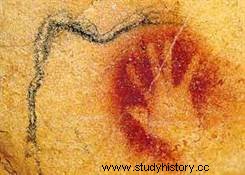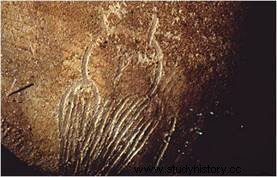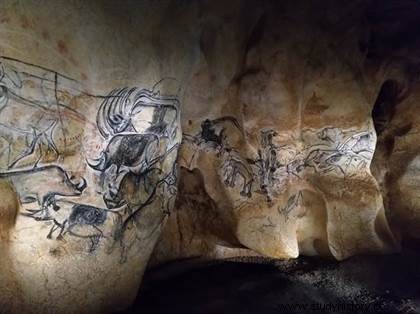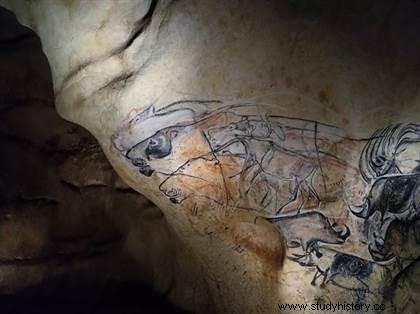 Located in the heart of the Cirque d'Estre in southern Ardèche, the cave decorated with Vallon Pont d'Arc known as Chauvet Cave is one of the jewels of Ardèche heritage. Discovered in 1994 by three speleologists, it has been classified as a UNESCO World Heritage Site and now has a Lascaux-type restitution area for visitors. The quality of the frescoes, the preparation of the walls and the use of the relief of the cave highlight an artistic mastery unknown for this time so remote, until the discovery of this cave.
Located in the heart of the Cirque d'Estre in southern Ardèche, the cave decorated with Vallon Pont d'Arc known as Chauvet Cave is one of the jewels of Ardèche heritage. Discovered in 1994 by three speleologists, it has been classified as a UNESCO World Heritage Site and now has a Lascaux-type restitution area for visitors. The quality of the frescoes, the preparation of the walls and the use of the relief of the cave highlight an artistic mastery unknown for this time so remote, until the discovery of this cave.
Who discovered the Chauvet Cave?
 The cave was discovered on December 18, 1994 by three speleologists from Ardèche:Jean Marie Chauvet , Eliette Brunel and Christian Hillaire. The entrance to the cave is located in the Ardèche gorges, near Vallon Pont d Arc . To be able to enter inside the speleologists went through a horizontal tube about 30 cm high and 6 meters long to reach the ceiling of a large room. Even today, researchers use this passage and it takes about thirty minutes to descend into the cave.
The cave was discovered on December 18, 1994 by three speleologists from Ardèche:Jean Marie Chauvet , Eliette Brunel and Christian Hillaire. The entrance to the cave is located in the Ardèche gorges, near Vallon Pont d Arc . To be able to enter inside the speleologists went through a horizontal tube about 30 cm high and 6 meters long to reach the ceiling of a large room. Even today, researchers use this passage and it takes about thirty minutes to descend into the cave.
It seems that the discovery of the cave is not due to chance, however, speleologists have been looking for a cave near the Pont d'Arc for several years. The cave was fairly quickly closed to the public (from 1995) for conservation reasons. Lascaux green disease being feared and even today only a few people can enter the cave with a limited time.
A complex dating
The dating of the paintings and engravings in the Chauvet Cave has proven to be tricky and controversial; a first fork was put forward in 2001, situating his parietal works between 32,000 and 17,000 BC. J.-C. footprints left by the teenager being dated 26,000 years ago). Geologists indicate for their part that the cave was definitively closed 20,000 years ago (thus occupied before this date). Dating from the Aurignacian, the paintings and engravings of Chauvet are therefore older than those of Lascaux, Altamira and Niaux.
After dating micro charcoal samples with Carbon 14, some drawings therefore date back to at least 36,000 years before our era . The cave was used by Cro-Magnon man until 20,000 BC. It was also the place of hibernation of bears and wolves whose traces are still visible today.
The Chauvet cave, summit of parietal art
The cave is made up of a vast underground network almost 500m long consisting of several rooms. The site has more than 1,000 cave paintings, 425 of which represent animals. Among these animals, there are more than 14 different species, the most represented of which are felines, mammoths and rhinos.
 It seems that the cave drawings are thoughtfully and organized by prehistoric man. Far from the image of the man with a shaggy beard and holding a club, which we all have in mind, it seems that prehistoric man was much smarter than we sometimes wanted to believe. Indeed, it is believed that some of the artists prepared their support before painting either by scraping the limestone or by managing to cause chemical reactions which led to emulsions before applying the paints and which are still visible in the cave today. today. In addition, the technique and the mastery of the drawing, visible thanks to numerous details, but also the rare species which are represented (such as the owl), command a certain respect and today make the Chauvet Cave one of the most beautiful ornate caves in the world.
It seems that the cave drawings are thoughtfully and organized by prehistoric man. Far from the image of the man with a shaggy beard and holding a club, which we all have in mind, it seems that prehistoric man was much smarter than we sometimes wanted to believe. Indeed, it is believed that some of the artists prepared their support before painting either by scraping the limestone or by managing to cause chemical reactions which led to emulsions before applying the paints and which are still visible in the cave today. today. In addition, the technique and the mastery of the drawing, visible thanks to numerous details, but also the rare species which are represented (such as the owl), command a certain respect and today make the Chauvet Cave one of the most beautiful ornate caves in the world.
A unique cave
This cave therefore appears as a unique jewel of Ardèche heritage. Unique first of all because of its exceptional state of conservation and that of its paintings which is due to the obstruction of its entrance by a landslide more than 20,000 years ago. Its state of conservation is also due to the protection with which it has been surrounded, in particular by closing it to the public and the measures taken when researchers enter the cave with the passage through several decontamination airlocks so as not to pollute the cave. . It is, thanks to these measures, the oldest decorated cave of humanity.
Unique also because of the magnificence and quality of the paintings represented which challenge our vision of prehistoric man. These symbolic, double-meaning or naturalized images portray to us a prehistoric man whose belief in spirits motivates artistic creation and the placement of cave paintings. These works are therefore conceived and executed with grace in a magical place that allows prehistoric man to reach the quintessence of his art.
 The cave has been declared a World Heritage Site by UNESCO, which will facilitate the protection and sharing this gem of parietal art. It is reproduced a few kilometers from the real one in order to open it to the public since the spring of 2015. The replica of the Chauvet cave, integrated into the Ardèche environment, was made by Périgord companies who had already worked on the facsimile of Lascaux. The visit lasts a little over an hour, and consists of a stroll along the restitution space. The temperature and lighting have been adapted to make the journey more immersive. It is advisable to favor the last time slot (5:30 p.m.) and to avoid the weekend to fully enjoy the visit.
The cave has been declared a World Heritage Site by UNESCO, which will facilitate the protection and sharing this gem of parietal art. It is reproduced a few kilometers from the real one in order to open it to the public since the spring of 2015. The replica of the Chauvet cave, integrated into the Ardèche environment, was made by Périgord companies who had already worked on the facsimile of Lascaux. The visit lasts a little over an hour, and consists of a stroll along the restitution space. The temperature and lighting have been adapted to make the journey more immersive. It is advisable to favor the last time slot (5:30 p.m.) and to avoid the weekend to fully enjoy the visit.
To go further on the Chauvet cave
- CHAUVET Jean Marie, La Grotte Chauvet pont d arc, Seuil, 1995
- CLOTTES Jean, The Chauvet cave:the art of origins, Seuil, 2010
Visit the Grotte Chauvet 2 Ardèche (Guided tour). Pont d'Arc cave, Ardèche department, Rhône Alpes Auvergne region.
